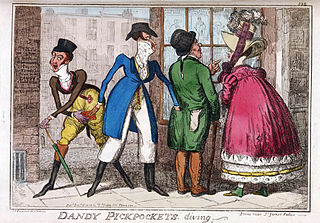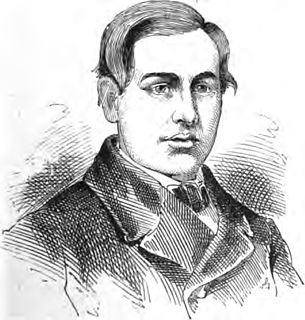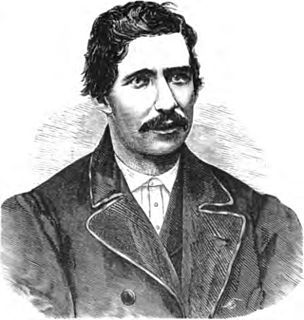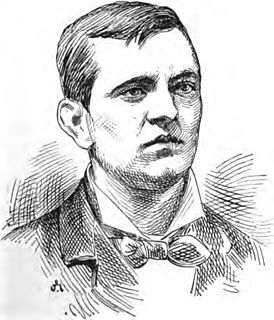
Pickpocketing is a form of larceny that involves the stealing of money or other valuables from the person or a victim's pocket without them noticing the theft at the time. It may involve considerable dexterity and a knack for misdirection. A thief who works in this manner is known as a pickpocket.

Jonathan Wild, also spelled Wilde, was a London underworld figure notable for operating on both sides of the law, posing as a public-spirited crimefighter entitled the "Thief-Taker General". Wild simultaneously ran a significant criminal empire, and used his crime fighting role to remove rivals and launder the proceeds of his own crimes.
The Hudson Dusters was a New York City street gang during the early twentieth century. Formed in the late 1890s by "Circular Jack", "Kid Yorke", and "Goo Goo Knox", the gang began operating from an apartment house on Hudson Street. Knox, a former member of the Gopher Gang, had fled after a failed attempt to gain leadership of the gang from then-leader Marty Brennan. However the two gangs later became allies during the gang wars against Gay Nineties gangs, the Potashes and Boodle Gangs, soon controlling most of Manhattan's West Side as far as 13th Street and eastern Broadway, bordering Paul Kelly's Five Points Gang to the north. While the gang dominated the West Side, it constantly battled smaller rival gangs including the Fashion Plates, the Pearl Buttons, and the Marginals for control of the Hudson River docks throughout the 1900s. Eventually, it drove the rival gangs out through sheer force of numbers, with over 200 members, not including the Gophers, who numbered several hundred more, controlling the waterfront by 1910.
The Crazy Butch Gang was an American juvenile street gang active in the New York City underworld during the late nineteenth century. Largely active in Manhattan's Lower East Side, the group were widely known as the cities top pickpockets and sneak thieves during the "Gay Nineties" period. An early member of this gang would later become known as a prominent New York gangster Jack Zelig.
The Dutch Mob was a New York pickpocket gang during the late nineteenth century.

Five Points Gang was a 19th-century and early 20th-century criminal organization, primarily of Italian-American origins, based in the Sixth Ward of Manhattan, New York City. In the early 19th century, the area was first known for gangs of Italian immigrants. Their descendants gradually moved out, to be followed by the next immigrants.
The rogue or thief is one of the standard playable character classes in most editions of the Dungeons & Dragons fantasy role-playing game. A rogue is a versatile character, capable of sneaky combat and nimble tricks. The rogue is stealthy and dexterous, and in early editions was the only official base class from the Player's Handbook capable of finding and disarming traps and picking locks. The rogue also has the ability to "sneak attack" enemies who are caught off-guard or taken by surprise, inflicting extra damage.

Joseph "Blueskin" Blake was an 18th-century English highwayman and prison escapee.

Margaret Brown was a New York criminal and thief during the late 19th century. She was most widely known under the name Old Mother Hubbard, after the nursery rhyme of that name, which was popular at the time. Among her aliases she also included the surnames Young and Haskins. She was one of the most well-publicized female thieves in the United States during the mid-to late 19th century and was part of Marm Mandelbaum's "inner circle" which included other notorious women such as Big Mary, Sophie Lyons, Queen Liz and Lena Kleinschmidt.
Henry D. Neuman or Neumann was a German-born American burglar, bank robber and gang leader known as Dutch Heinrichs. A member of Chauncey Johnson's burglary gang during the late 1860s, he was also the founder of the Hell's Kitchen Gang which terrorized West Manhattan for over two decades.
The Baxter Street Dudes was a New York teenage street gang, consisting of former newsboys and bootblacks, who ran the Grand Duke's Theatre from the basement of a dive bar on Baxter Street during the 1870s. Led by founder Baby-Face Willie, gang members operated the Grand Duke's Theatre and established the venue as their headquarters. Members of the Baxter Street Dudes wrote and performed plays, musicals and variety shows which were enjoyed by other street toughs and slummers throughout the city. The theater house eventually became a popular underworld hangout, from which the gang found financial success.

Sophie Lyons was an American criminal and one of the country's most notorious female thieves, pickpockets, shoplifters, and confidence women during the mid-to-late 19th century. She and her husbands Ned Lyons, Jim Brady and Billy Burke were among the most sought-after career criminals in the U.S. and Canada, being wanted in several major cities including New York City, Philadelphia, Boston, Detroit and Montreal from the 1860s until the turn of the 20th century.
Queen Liz was the pseudonym of an American thief and pickpocket who was a prominent member of New York's underworld during the mid-to late 19th century. She was among the elite "inner circle" of female career criminals under Marm Mandelbaum during the 1860s and 1870s. Among these included fellow thieves, blackmailers and confidence women such as Lena Kleinschmidt, Sophie Lyons, Kid Glove Rosey, Little Annie, Big Mary and Old Mother Hubbard, all of whom were regular guests at her extravagant dinner parties.

Dan Noble, also known as Daniel Dyson, (1846-?) was an English gentleman burglar, confidence man, sneak thief and pickpocket active in the United States during the mid-to late 19th century. One of the most notorious criminals in New York City, he was involved in several major robberies in the post-American Civil War era. Among his exploits included the daylight robbery of the Royal Insurance Company in 1866 and was an alleged participant in the theft of $1,000,000 from industrialist Rufus L. Lord arraigned by George Leonidas Leslie in 1876.
Tom Flaherty, more commonly known under his pseudonym Old Flaherty, was an American criminal, sneak thief and river pirate in New York City during the mid-to late 19th century. He was the patriarch of a criminal family in New York's Seventh Ward which terrorized the New York waterfront in the post-American Civil War era. Flaherty was described as having "long white whiskers and a benevolent smile, but he was one of the most cruel thugs of the Seventh Ward".

Patrick Conway, commonly known by his alias Patsy or Patsy Conroy, was an American burglar and river pirate. He was the founder and leader of the Patsy Conroy Gang, a gang of river pirates active on the New York waterfront in the old Fourth Ward and Corlears' Hook districts during the post-American Civil War era.

John "Johnny" Hope (1856–1906) was a 19th-century American burglar, bank robber and pickpocket. The son of James "Old Jimmy" Hope, he was alleged to have been associated with his father and the George Leslie Gang. He was among those arrested for the 1878 robbery of the Manhattan Savings Institution although he and Billy Kelly were the only men actually sent to prison for this crime.
Michael Mahoney, better known as Wreck Donovan or simply The Wreck, was a nineteenth-century American sneak thief, river pirate and underworld figure in New York City. He was a well-known criminal for hire on the New York waterfront during the post-American Civil War era and later became a member of Patsy Conroy Gang.
Jenny Diver, née Mary Young was a notorious Irish pickpocket, one of the most famous of her day.

Cheyenne Rides Again is a 1937 western film directed by Robert F. Hill. It stars Tom Tyler and Lon Chaney Jr.. Much as did Alfred Hitchcock in his own films, director Hill appears in a cameo as townsman "Bartender Ed".










